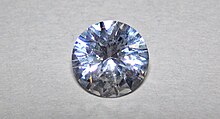
Back YAG Afrikaans Granat d'itri d'alumini Catalan Yttrito-hlinitý granát Czech Yttrium-Aluminium-Granat German Γρανάτης αργιλίου-υττρίου Greek Granate de itrio y aluminio Spanish گارنت ایتریوم آلومینیوم Persian Yttriumalumiinigranaatti Finnish Grenat d'yttrium et d'aluminium French Granato di ittrio e alluminio Italian
| Yttrium aluminium garnet | |
|---|---|
 | |
| General | |
| Category | synthetic mineral |
| Formula (repeating unit) | Y3Al5O12 |
| Crystal system | Cubic |
| Identification | |
| Color | Usually colorless, but may be pink, red, orange, yellow, green, blue, purple |
| Cleavage | None |
| Fracture | Conchoidal to uneven |
| Mohs scale hardness | 8.5 |
| Luster | Vitreous to subadamantine |
| Specific gravity | 4.5–4.6 |
| Polish luster | Vitreous to subadamantine |
| Optical properties | Single refractive |
| Refractive index | 1.833±0.010 |
| Birefringence | None |
| Pleochroism | None |
| Dispersion | 0.028 |
| Ultraviolet fluorescence | Colorless stones - inert to moderate orange in long wave, inert to weak orange in short wave; blue and pink stones - inert; yellow-green stones - very strong yellow in long and short wave also phosphoresces; green stones - strong red in long wave, weak red in short wave |
| References | [1] |
Yttrium aluminium garnet (YAG, Y3Al5O12) is a synthetic crystalline material of the garnet group. It is a cubic yttrium aluminium oxide phase, with other examples being YAlO3 (YAP[2]) in a hexagonal or an orthorhombic, perovskite-like form, and the monoclinic Y4Al2O9 (YAM[3]).[4]
Due to its broad optical transparency,[5] low internal stress, high hardness, chemical and heat resistance, YAG is used for a variety of optics.[6] Its lack of birefringence (unlike sapphire) makes it an interesting material for high-energy/high-power laser systems. Laser damage levels of YAG ranged from 1.1 to 2.2 kJ/cm2 (1064 nm, 10 ns).[7]
YAG, like garnet and sapphire, has no uses as a laser medium when pure. However, after being doped with an appropriate ion, YAG is commonly used as a host material in various solid-state lasers.[8] Rare earth elements such as neodymium and erbium can be doped into YAG as active laser ions, yielding Nd:YAG and Er:YAG lasers, respectively. Cerium-doped YAG (Ce:YAG) is used as a phosphor in cathode ray tubes and white light-emitting diodes, and as a scintillator.
- ^ Gemological Institute of America, GIA Gem Reference Guide 1995, ISBN 0-87311-019-6
- ^
"YAlO
3; YAP (YAlO
3 ht) Crystal Structure". Springer Materials. Retrieved 2019-12-23.. - ^
"Y
4Al
2O
9; YAM (Y
4Al
2O
9 rt) Crystal Structure". Springer Materials. Retrieved 2020-01-28. - ^ Sim, S.M.; Keller, K.A.; Mah, T.I. (2000). "Phase formation in yttrium aluminium garnet powders synthesized by chemical methods". Journal of Materials Science. 35 (3): 713–717. Bibcode:2000JMatS..35..713S. doi:10.1023/A:1004709401795. S2CID 92455146.
- ^ Franta, Daniel; Mureșan, Mihai-George (2021-12-01). "Wide spectral range optical characterization of yttrium aluminum garnet (YAG) single crystal by the universal dispersion model". Optical Materials Express. 11 (12): 3930. Bibcode:2021OMExp..11.3930F. doi:10.1364/OME.441088. ISSN 2159-3930. S2CID 239534251.
- ^ "Custom YAG (Yttrium Aluminium Garnet, Yttrium Aluminium Oxide Y3Al5O12) optics". Knight Optical. Retrieved 2022-03-15.
- ^ Do, Binh T.; Smith, Arlee V. (2009-06-20). "Bulk optical damage thresholds for doped and undoped, crystalline and ceramic yttrium aluminum garnet". Applied Optics. 48 (18): 3509–3514. Bibcode:2009ApOpt..48.3509D. doi:10.1364/AO.48.003509. ISSN 0003-6935. PMID 19543361.
- ^ Kalisky, Yehoshua (1997). "Hosts for Solid State Luminescent Systems". In Rotman, Stanley R. (ed.). Wide-Gap Luminescent Materials: Theory and Applications: Theory and Applications. Springer Science & Business Media. ISBN 9780792398370.
© MMXXIII Rich X Search. We shall prevail. All rights reserved. Rich X Search